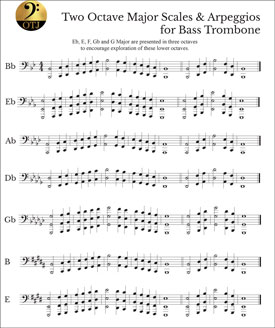Two Octave Major Scales & Arpeggios for Bass Trombone
 Get the Two Octave Major Scales & Arpeggios for Bass Trombone PDF
Get the Two Octave Major Scales & Arpeggios for Bass Trombone PDF
As a bass trombonist, you act as a bridge between the trombones and the tubas, often venturing down far below the staff. One of the most beneficial areas of practice to build your skill in this area is working on two octave major scales. Most of the music you will play over your performing career will be based on some form of a scale, so practicing them should be a part of your daily routine.
For a bass trombonist, scale practice down to the bottom end of the instrument is critical for mastery. You've probably already been working into the pedal register - after all, it's fun! Now, let's put that fun to work.
In the scale PDF attached to this article, you will find all the major scales and their arpeggios written in two octaves and focused on the bass trombone register. You'll notice that E♭, E, F, G♭, and G major are notated with three octaves. This is because working into the trigger registers on pedals can be a bit of a challenge. Remember that the positions for pedal register notes on the F-attachment are the same as the octave above in the trigger register (E♭ down to B below the staff). If you experience a challenge playing any of the lower pedal notes, start on one you can play and slowly glissando down towards the target note. Repeat this several times, keeping the volume around mezzo piano. Save the fortissimo work for later, for this moment, accuracy is key, not volume. As you improve, I bet you can figure out the positions for the other scales down to double-pedal B♭! Also - don't be afraid to work above high G. We bass trombonists often have to play up there in many ensembles.
Be sure to mark your breathing to make it an integral part of scale practice. For G major and above, I recommend playing the lower octave, take a breath, then play the upper octave up and down, breath, then the lower octave. For G♭ and below, I recommend playing the lower octave in one breath, then the upper octave up and down in one breath, a breath before the lower octave, and if necessary, take a breath on the lower octave between the first and second beats of the third measure of the scales. If you need more air, breathe as necessary. As we are all different, what I do may or may not work for you when it comes to breathing.
Start slow, as accuracy is more important than speed and always use a metronome. As you grow in your mastery of the scales, begin working for a slightly faster tempo and add in volume variations from pianissimo to fortissimo, and vary your articulations. Plan out your week's practice to cover all dynamics and many articulations: slurred, staccato, marcato, slur two/tongue two, tongue two/slur two, etc.
Always use a metronome and record yourself. Listening to the recording is far more revealing than trusting your ear and mind to remember the issues you experienced while playing the scale.
This is also a perfect time in your performing career to seek out a professional trombone teacher for lessons. Having a mentor to guide you will speed your progress and help you to make the most of your efforts.
James Markey talks about switching to/doubling on bass trombone.
James Markey talks about the extreme low register of the bass trombone.
Now go practice, or as one of my teachers once told me: "Practice now, because you won't have time later."
Get the Two Octave Major Scales & Arpeggios for Bass Trombone PDF
